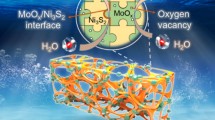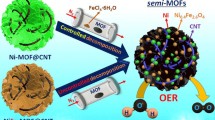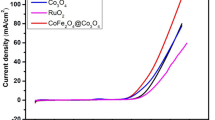Abstract
Develo** a facile approach to fabricate robust electrocatalysts for the oxygen evolution reaction (OER) is essential for water electrolysis for hydrogen production. Transition metal-organic frameworks (MOFs), with their diverse coordination geometries, offer a promising avenue for deriving materials with excellent electrocatalytic properties. Leveraging the distinct controllable synthesis features of two-dimension graphdiyne (2D-GDY), we herein present a novel strategy: Loading GDY in situ onto a MOF-derived Co3S4/nickel foam (NF) material to create a self-supported electrode, GDY/Co3S4/NF, exhibiting significantly enhanced electrocatalytic performances for OER. Our comprehensive investigation reveals that GDY/Co3S4/NF demonstrates superior performance, with a low overpotential of 223 mV at a current density of 10 mA cm−2 and a small Tafel slope of 46.5 mV dec−1. Notably, it showcases exceptional stability over 45 h of continuous electrolysis at a high current density of 100 mA cm−2 under alkaline conditions, highlighting its promising practical applicability. These results validate that the unique acetylene bonds and macroporous structure of 2D-GDY enable strong electronic interactions with Co3S4, thereby tuning the electronic configuration, facilitating efficient charge transport channels, increasing active surface areas, and enhancing durability. Furthermore, in-situ attenuated total reflection surface-enhanced infrared spectroscopy (in-situ ATR-SEIRAS) analysis reveals that the synergistic effect between GDY and Co3S4 promotes the adsorption of crucial intermediate species such as OOH⋆, thereby significantly improving the electrocatalytic activity for OER. This work presents a facile and efficient strategy for constructing advanced nanomaterials with extraordinary electrocatalytic performance, offering promising prospects for various practical applications.

摘要
制备高效的OER电催化剂对水裂解制氢至关重要. 具有丰富配位 构型的MOFs可以衍生出各种优良的电催化材料. 由于石墨炔(GDY)具 有独特的可控合成特性, 我们将其原位复合在MOF衍生的Co3S4/NF材 料上, 获得了自支撑电极GDY/Co3S4/NF, 大大提高了其OER催化性能. 研究表明, GDY/Co3S4/NF在10 mA cm−2电流密度下表现出223 mV的低 过电位, 在100 mA cm−2的大电流密度下, 能够稳定电解45小时左右, 该 材料显示出了巨大的实际应用潜力. 结果表明, 由于GDY独特的炔键和 大孔结构, 它可以通过**电子相互作用与Co3S4相互作用, 从而调节电 子结构并提供有效的电荷转移通道, 从而大大提高了其电催化OER的 性能.
Similar content being viewed by others
References
Kwak WJ, Rosy WJ, Sharon D, et al. Lithium-oxygen batteries and related systems: potential, status, and future. Chem Rev, 2020, 120: 6626–6683
Jaramillo TF, Jørgensen KP, Bonde J, et al. Identification of active edge sites for electrochemical H2 evolution from MoS2 nanocatalysts. Science, 2007, 317: 100–102
Chulliyote R, Hareendrakrishnakumar H, Raja M, et al. Sulfur-immobilized nitrogen and oxygen co-doped hierarchically porous biomass carbon for lithium-sulfur batteries: Influence of sulfur content and distribution on its performance. Chem Select, 2017, 2: 10484–10495
Anantharaj S, Noda S, Jothi VR, et al. Strategies and perspectives to catch the missing pieces in energy-efficient hydrogen evolution reaction in alkaline media. Angew Chem Int Ed, 2021, 60: 18981–19006
Wang J, Zhang Z, Ding J, et al. Recent progresses of micro-nanostructured transition metal compound-based electrocatalysts for energy conversion technologies. Sci China Mater, 2021, 64: 1–26
Yang Y, Zhang K, Lin H, et al. MoS2-Ni3S2 heteronanorods as efficient and stable bifunctional electrocatalysts for overall water splitting. ACS Catal, 2017, 7: 2357–2366
Kibsgaard J, Chorkendorff I. Considerations for the scaling-up of water splitting catalysts. Nat Energy, 2019, 4: 430–433
Ouyang T, Wang X, Mai X, et al. Coupling magnetic single-crystal Co2Mo3O8 with ultrathin nitrogen-rich carbon layer for oxygen evolution reaction. Angew Chem Int Ed, 2020, 59: 11948–11957
Yang D, Chen D, Jiang Y, et al. Carbon-based materials for all-solidstate zinc-air batteries. Carbon Energy, 2020, 3: 50–65
Liu Q, **e L, Qu F, et al. A porous Ni3N nanosheet array as a highperformance non-noble-metal catalyst for urea-assisted electrochemical hydrogen production. Inorg Chem Front, 2017, 4: 1120–1124
Shi Q, Zhu C, Du D, et al. Robust noble metal-based electrocatalysts for oxygen evolution reaction. Chem Soc Rev, 2019, 48: 3181–3192
Shahzad A, Zulfiqar F, Arif Nadeem M. Cobalt containing bimetallic ZIFs and their derivatives as OER electrocatalysts: A critical review. Coord Chem Rev, 2023, 477: 214925
Sahu N, Behera JN. MOF-derived Co3S4 nanoparticles embedded in nitrogen-doped carbon for electrochemical oxygen production. ACS Appl Nano Mater, 2023, 6: 7686–7693
Lamiel C, Hussain I, Rabiee H, et al. Metal-organic framework-derived transition metal chalcogenides (S, Se, and Te): Challenges, recent progress, and future directions in electrochemical energy storage and conversion systems. Coord Chem Rev, 2023, 480: 215030
Li S, Gao Y, Li N, et al. Transition metal-based bimetallic MOFs and MOF-derived catalysts for electrochemical oxygen evolution reaction. Energy Environ Sci, 2021, 14: 1897–1927
Qin X, Kim D, Piao Y. Metal-organic frameworks-derived novel nanostructured electrocatalysts for oxygen evolution reaction. Carbon Energy, 2021, 3: 66–100
Xue X, Gao H, Liu J, et al. Electrostatic potential-derived charge: A universal OER performance descriptor for MOFs. Chem Sci, 2022, 13: 13160–13171
Wang T, Gao L, Hou J, et al. Rational approach to guest confinement inside MOF cavities for low-temperature catalysis. Nat Commun, 2019, 10: 1–9
Yang D, Chen Y, Su Z, et al. Organic carboxylate-based MOFs and derivatives for electrocatalytic water oxidation. Coord Chem Rev, 2021, 428: 213619
Li Z, Song M, Zhu W, et al. MOF-derived hollow heterostructures for advanced electrocatalysis. Coord Chem Rev, 2021, 439: 213946
Zong H, Qi R, Yu K, et al. Ultrathin Ti2NTx MXene-wrapped MOF-derived CoP frameworks towards hydrogen evolution and water oxidation. Electrochim Acta, 2021, 393: 139068
Fu Y, Wang W, Wang J, et al. MOFs-derived ZnCo-Fe core-shell nanocages with remarkable oxygen evolution reaction performance. J Mater Chem A, 2019, 7: 17299–17305
Guo Y, Zhang C, Zhang J, et al. Metal-organic framework-derived bimetallic NiFe selenide electrocatalysts with multiple phases for efficient oxygen evolution reaction. ACS Sustain Chem Eng, 2021, 9: 2047–2056
Xu H, Cao J, Shan C, et al. MOF-derived hollow CoS decorated with CeOx nanoparticles for boosting oxygen evolution reaction electrocatalysis. Angew Chem Int Ed, 2018, 57: 8654–8658
Nguyen AN, Tran NM, Yoo H. Direct growth and post-treatment of zeolitic imidazolate framework-67 on carbon paper: An effective and stable electrode system for electrocatalytic reactions. J Mater Chem A, 2022, 10: 20770–20778
Bao T, **a Y, Lu J, et al. A pacman-like titanium-doped cobalt sulfide hollow superstructure for electrocatalytic oxygen evolution. Small, 2022, 18: 2103106
Santhosh Kumar R, Karthikeyan SC, Ramakrishnan S, et al. Anion dependency of spinel type cobalt catalysts for efficient overall water splitting in an acid medium. Chem Eng J, 2023, 451: 138471
Jiang X, **e Q, Lu G, et al. Synthesis of NiSe2/Fe3O4 nanotubes with heteroepitaxy configuration as a high-efficient oxygen evolution electrocatalyst. Small Methods, 2022, 6: 2200377
Lin YH, Zhang Q, Ding SC, et al. NiFe nanoparticle nest supported on graphene as electrocatalyst for highly efficient oxygen evolution reaction. Small, 2023, 20: 2308278
Lin L, Wang Y, Ye Q, et al. Rapid fabrication of FexNi2-xP4O12 and graphene hybrids as electrocatalyst for highly efficient oxygen evolution reaction. Appl Catal B-Environ, 2023, 334: 122834
Chen X, Zheng X, Zhang C, et al. Highly selective conversion of CO2 to formate on SnOx/GDY heterostructured electrocatalyst. Nano Energy, 2023, 114: 108622
Wang M, Pu J, Hu Y, et al. Functional graphdiyne for emerging applications: Recent advances and future challenges. Adv Funct Mater, 2024, 34: 2308601
Li G, Li Y, Liu H, et al. Architecture of graphdiyne nanoscale films. Chem Commun, 2010, 46: 3256
Zuo Z, Wang D, Zhang J, et al. Synthesis and applications of graphdiyne-based metal-free catalysts. Adv Mater, 2019, 31: 1803762
Gao X, Liu H, Wang D, et al. Graphdiyne: synthesis, properties, and applications. Chem Soc Rev, 2019, 48: 908–936
Li M, Wang K, Lv Q. N,P-co-doped graphdiyne as efficient metal-free catalysts for oxygen reduction reaction. Chem Res Chin Univ, 2021, 37: 1283–1288
Xue Y, Huang B, Yi Y, et al. Anchoring zero valence single atoms of nickel and iron on graphdiyne for hydrogen evolution. Nat Commun, 2018, 9: 1460
Shi GD, **e YL, Du LL, et al. Constructing Cu–C bonds in a graphdiyne-regulated Cu single-atom electrocatalyst for CO2 reduction to CH4. Angew Chem Int Ed, 2022, 61: e202203569
Fu X, Zhao X, Lu T, et al. Graphdiyne-based single-atom catalysts with different coordination environments. Angew Chem Int Ed, 2023, 62: e202219242
Gao Y, Cai Z, Wu X, et al. Graphdiyne-supported single-atom-sized fe catalysts for the oxygen reduction reaction: DFT predictions and experimental validations. ACS Catal, 2018, 8: 10364–10374
Wang S, Che Z, Zou M, et al. Gorgeous turn-back: Rough surface treatment strategy induces Cu-C and N-C active moieties for bifunctional oxygen electrocatalysis. Chem Eng J, 2023, 471: 144262
Chen B, Jiang YF, **ao H, et al. Bimetallic single-cluster catalysts anchored on graphdiyne for alkaline hydrogen evolution reaction. Chin J Catal, 2023, 50: 306–313
Wang Z, Zheng Z, Xue Y, et al. Acidic water oxidation on quantum dots of IrOx/graphdiyne. Adv Energy Mater, 2021, 11: 2101138
Qi L, Chen Z, Luan X, et al. Atomically dispersed Mn enhanced catalytic performance for overall water splitting on graphdiyne-coated copper hydroxide nanowire. Chin J Struct Chem, 2024, 43: 100197
Liu Y, Xue Y, Yu H, et al. Graphdiyne ultrathin nanosheets for efficient water splitting. Adv Funct Mater, 2021, 31: 2010112
Yu S, Chen J, Chen C, et al. What happens when graphdiyne encounters do** for electrochemical energy conversion and storage. Coord Chem Rev, 2023, 482: 215082
Qi L, Gao Y, Gao Y, et al. Controlled growth of metal atom arrays on graphdiyne for seawater oxidation. J Am Chem Soc, 2024, 146: 5669–5677
Zheng Z, Xue Y, Li Y. A new carbon allotrope: graphdiyne. Trends Chem, 2022, 4: 754–768
Qi L, Zheng Z, **ng C, et al. 1D nanowire heterojunction electrocatalysts of MnCo2O4/GDY for efficient overall water splitting. Adv Funct Mater, 2022, 32: 2107179
Chen X, Fu X, Zhang S, et al. Graphdiyne in situ thermal reduction enabled ultra-small quasi-core/shell Ru-RuO2 heterostructures for efficient acidic water oxidation. 2D Mater, 2021, 8: 044011
Wang S, Yi L, Halpert JE, et al. A novel and highly efficient photocatalyst based on P25-graphdiyne nanocomposite. Small, 2012, 8: 265–271
Zhao XJ, Fang XL, Wu BH, et al. Facile synthesis of size-tunable ZIF-8 nanocrystals using reverse micelles as nanoreactors. Sci China Chem, 2014, 57: 141–146
Li G, Wang P, Li C, et al. Cobalt-nickel layered double hydroxide on hollow Co3S4/CuS derived from ZIF-67 for efficient overall water splitting. Mater Res Lett, 2022, 10: 744–753
Yang Y, Ma Q, Han L, et al. Zeolitic imidazolate framework-derived Co3S4@Co(OH)2 nanoarrays as self-supported electrodes for asymmetric supercapacitors. Inorg Chem Front, 2019, 6: 1398–1404
Ji K, Che Q, Yue Y, et al. Ni-doped Co3S4 hollow nanobox for the hydrogen evolution reaction. ACS Appl Nano Mater, 2022, 5: 9901–9909
Lee YJ, Park S. Metal-organic framework-derived hollow CoSx nanoarray coupled with NiFe layered double hydroxides as efficient bifunctional electrocatalyst for overall water splitting. Small, 2022, 18: 2200586
Guo Y, Tang J, Qian H, et al. One-pot synthesis of zeolitic imidazolate framework 67-derived hollow Co3S4@MoS2 heterostructures as efficient bifunctional catalysts. Chem Mater, 2017, 29: 5566–5573
Ren Y, Wang H, Zhang T, et al. Designed preparation of CoS/Co/MoC nanoparticles incorporated in N and S dual-doped porous carbon nanofibers for high-performance Zn-air batteries. Chin Chem Lett, 2021, 32: 2243–2248
Rao P, Liu Y, Su YQ, et al. S, N co-doped carbon nanotube encased Co NPs as efficient bifunctional oxygen electrocatalysts for zinc-air batteries. Chem Eng J, 2021, 422: 130135
Li X, Zheng K, Zhang J, et al. Engineering sulfur vacancies in spinelphase Co3S4 for effective electrocatalysis of the oxygen evolution reaction. ACS Omega, 2022, 7: 12430–12441
Li Z, Xu W, Yu X, et al. Synergistic effect between 1D Co3S4/MoS2 heterostructures to boost the performance for alkaline overall water splitting. Inorg Chem Front, 2022, 9: 2139–2149
Liu H, Zhang Z, Fang J, et al. Eliminating over-oxidation of ruthenium oxides by niobium for highly stable electrocatalytic oxygen evolution in acidic media. Joule, 2023, 7: 558–573
Cheng W, Zhao X, Su H, et al. Lattice-strained metal-organic-framework arrays for bifunctional oxygen electrocatalysis. Nat Energy, 2019, 4: 115–122
Liu H, Qi Z, Song L. In situ electrocatalytic infrared spectroscopy for dynamic reactions. J Phys Chem C, 2021, 125: 24289–24300
Kumar G, Haldar R, Shanmugam M, et al. Mechanistic insight into a Co-based metal-organic framework as an efficient oxygen electrocatalyst via an in situ FT-IR study. J Mater Chem A, 2023, 11: 26508–26518
**n S, Tang Y, Jia B, et al. Coupling adsorbed evolution and lattice oxygen mechanism in Fe-Co(OH)2/Fe2O3 heterostructure for enhanced electrochemical water oxidation. Adv Funct Mater, 2023, 33: 2305243
Li X, Deng C, Kong Y, et al. Unlocking the transition of electrochemical water oxidation mechanism induced by heteroatom do**. Angew Chem Int Ed, 2023, 62: e202309732
Acknowledgements
This work was supported by the National Natural Science Foundation of China (22375148) and the National Key R&D Program of China (2022YFA1502902).
Author information
Authors and Affiliations
Contributions
Author contributions Lu M and Zhang S designed and engineered the samples; Lu M, Zhao X and Zhang S performed the experiments; Jian H did some analyses. Wang M and Lu M wrote the paper with support from Lu T. Lu T and Wang M administrated the project, supervised the experiments and reviewed the manuscript. All authors contributed to the general discussion.
Corresponding authors
Ethics declarations
Conflict of interest The authors declare that they have no conflict of interest.
Additional information
Supplementary information Experimental details and supporting data are available in the online version of the paper.
Mengyu Lu is a graduate student at the School of Materials Science and Engineering, Tian** University of Technology. She received her BE degree from the Jiangxi University of Science and Technology in 2022. She is mainly engaged in the application of metal-based nanomaterials in electrocatalysis.
Mei Wang received her PhD degree in 2009 at the Fujian Institute of Research on the Structure of Matter, Chinese Academy of Sciences. Then she worked as a postdoctoral fellow at Max-Planck Institute for Chemical Energy Conversion. She is currently an associate professor at Tian** University of Technology, working on metalbased complexes and nanomaterials synthesis, and exploring their applications in electrocatalysis.
Tongbu Lu obtained his BS in 1988 and PhD in 1993 from Lanzhou University. He joined the Sun Yat-Sen University and became a professor in 2000. In 2016, he moved to Tian** University of Technology. His current research interest focuses on the study of artificial photosynthesis, including the design of homogeneous and heterogeneous catalysts for water splitting and CO2 reduction. He obtained the National Natural Science Foundation for Distinguished Youth Scholar in 2006.
Electronic supplementary material
About this article
Cite this article
Lu, M., Zhao, X., Zhang, S. et al. Stabilization of MOF-derived Co3S4 nanoparticles via graphdiyne coating for efficient oxygen evolution. Sci. China Mater. 67, 1882–1890 (2024). https://doi.org/10.1007/s40843-024-2956-9
Received:
Accepted:
Published:
Issue Date:
DOI: https://doi.org/10.1007/s40843-024-2956-9




